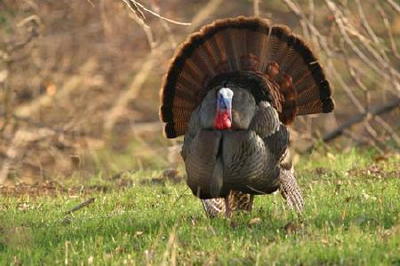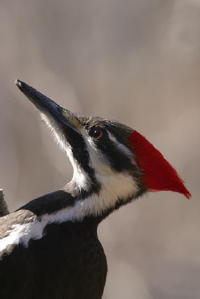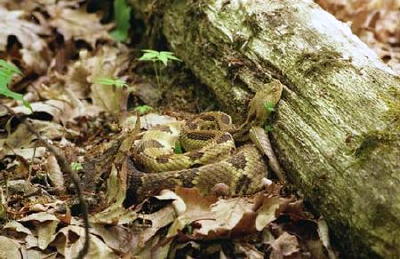Nature's images
Knowledge of wildlife inspires photographer
By John McCoy
Staff writer
www.wvgazette.com
Mark Shock's job keeps him close to nature. His hobby lets him reach out and capture it.
Shock manages wildlife for the state Division of Natural Resources. In his spare time, the 55-year-old Grantsville resident takes award-winning photographs of the animals he manages.
"I've been into wildlife photography for quite a while, but I wasn't serious about it until recently," Shock said.

Of all amateur photographer Mark Shock's wildlife subjects, turkeys are among the most difficult to capture because of their wariness
He started taking pictures during sightseeing trips with wife, Linda.
"We'd pick a place on the map and just travel to it to see what was there," he said. "We always seemed to take a lot of pictures on those trips. As the years went along, I got more interested in photography."

A close-up of a pileated woodpecker, captured from a blind near Shock's Grantsville home, earned him a "people's choice" award for bird photography at a recent international wildlife conference
Shock knows animal behavior better than most photographers. He'd better. His work requires him to trap turkeys, band geese, relocate rogue bears and perform other wildlife-related tasks throughout the state's northwestern counties. Four or five years ago, he decided to take advantage of that knowledge.
"It struck me that I should try to do more wildlife photography," he said.
He did. He discovered a lot of the process was out of his control.
"It's extremely time-consuming," he said. "You have wait and wait for animals to come to you. The light changes constantly, and the animals never seem to want to sit still."
Shock began to carry a camera on trips afield for the DNR. He soon learned, however, that his duties didn't allow much time for picture taking.
"It's hard to mix photography with work," he said. "Just when you think you're about to get something really good, you have to go do something else. Most of my wildlife photography is on my own time."
He photographs everything from deer to rattlesnakes. He's particularly fond of birds, mainly because they present so many challenges.
"Songbirds are hardest to photograph because they're quick, and they move around so much," he said. "Turkeys are tough, too, because they're so wary. They'll spook at the least sound or movement."
Shock switched from film cameras to digital in 2001, and instantly became more able to capture difficult subjects.
"With film, I ended up throwing out a lot of slides and negatives with blurred images on them," he said. "Sometimes I'd shoot two or three rolls of film just to get one or two decent frames."
The dim light penetrating the forest canopy forced Shock to use shutter speeds too slow to capture quick-moving subjects on film.
"Digital was just what the doctor ordered," he said. "If some of the shots were blurred, I could just delete them off the memory card. There was no film to buy, and there was no film-processing cost."
Shock's Canon D60 digital camera cost substantially more than his film cameras, but it freed him up to trip the shutter as often as he wanted.
"That's the beauty of digital," he said. "If you shoot 50 or 60 shots and don't like any of them, you can just dump them from the memory card. You also don't mind risking an extra shot or two, because with digital it's not going to cost additional money."
With a few clicks of a computer mouse, Shock could review, edit and store all the images he liked. His portfolio quickly grew.
People who saw his images liked them, but he never tried to sell them or have them published.
"I just did it for my own personal satisfaction," he said.
Then in September, his DNR bosses sent him to a National Wildlife Society meeting in Calgary, Canada.
"They had a photo contest, and I decided to enter it," he said.
He submitted photos in five of the contest's seven categories. The results surprised him.
In three of the categories, he won "people's choice" awards, given to the photos conference attendees liked best. In the portion of the contest judged by professional photographers, he took two seconds and a third.
The three people's choice awards meant most to him, he said.
"I never dreamed I'd get anything like that," he added.
Shock doesn't plan to exploit the recognition he received. "I like to donate my photos to the DNR's wildlife magazine, but that's about it," he said. "Linda says I should think about selling pictures to offset the equipment expense, but that would take a lot of time. I have a lot of other things I'd rather do."
Taking photos, for instance.
"That's about it," he said. "I don't do this for the money."
To contact staff writer John McCoy, use e-mail or call 348-1231.
Read McCoy's OUTDOOR columns covering a wide range of West Virginia outdoors.

Mark Shock doesn't restrict his photography to charismatic wildlife subjects. His photo of a Gilmer County timber rattler also impressed contest judges. When he's not taking pictures, Shock manages wildlife for the state Division of Natural Resources
| 


